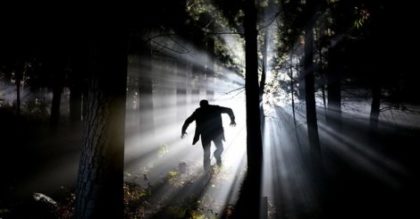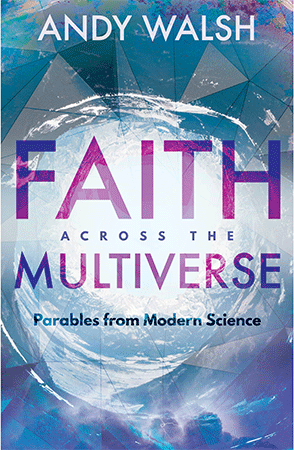
Twenty five years after the original Jurassic Park film brought photo-realistic digital dinosaurs to the big screen, the latest entry in the franchise opens this weekend. While covering the previous film, I brought up Mary Shelley’s Frankenstein and the influence it has on the Jurassic stories and also our perception of science, especially biology. This year is also the 200th anniversary of that novel, first published in 1818 when Shelley was just 20. In honor of that milestone, several universities have put it on their summer reading list. Shelley’s story will also be the springboard for my upcoming talk at this year’s ASA meeting. So it seems like a good time to explore some of the themes of Frankenstein and the world of Jurassic Park.
First, a little context. The word ‘biology’ was less than 100 years old in 1818, having first appeared in the writing of Carl Linnaeus, and the idea of biology as the name for a distinct scientific discipline arose essentially contemporaneously with Frankenstein. Obviously medicine and farming and other knowledge about living things is much older, but there was little to unify or formalize such knowledge until the 19th century–the taxonomic work of Linnaeus being a notable exception. Among the central concepts of biology still to be discovered in 1818: cell theory, the idea that the cell is the basic unit of all living things; Mendelian genetics; Darwin’s theory of evolution; germ theory; everything related to DNA and proteins. In essence, modern biology has grown up alongside Frankenstein and the science fiction genre. Without a control group, it’s difficult to quantify how that has influenced the science and our perception of it, but it’s easy to imagine there has been and continues to be some effect.
Frankenstein has some theological aspirations as well. Dr. Frankenstein creates a new form of life, a privilege previously reserved only for God–at least within the Christian tradition which informed the western European cultural context of the novel. As a result, his creature is compared to Adam, both the first of their kind. That western European cultural context also includes a literary tradition which Shelley also participates in; her idea of Adam owes at least as much to Milton’s Paradise Lost as to Genesis. Is the creature free from the burden of original sin by virtue of his unique ‘birth’? Is he unspoilt by the possibly corrupting influences of civilization? As European colonizers interacted with people groups that existed outside of the western tradition (thanks to developments in long-range transportation), they wondered what differences were the result of their different traditions and what differences were biological, the classic nature vs nurture conversation. Dr. Frankenstein’s creature is a thought experiment about how to test some of those questions experimentally.
In light of what we’ve learned biologically and theologically in 200 years, we can revisit some of the questions and answers offered by Shelley and see if we come to different conclusions.
- Many applications of modern biology raise the specter of “playing God” and unleashing new monsters in a way pre-Frankenstein methods do not. For example, domestication and cultivation of food crops has introduced dramatic changes to their biology. But genetic engineering of those same crops to produce more subtle changes faces strong opposition. Would we be as concerned about genetically modified organisms if it weren’t so easy and reflexive to label them “Frankenfood”?
- Dr. Frankenstein’s work did not end well for anyone involved, making it a cautionary tale for biological experimentation; Jurassic Park is similarly pessimistic. At the same time, they are pure fiction. Should these stories encourage us to take caution with real life experiments, such as applications of gene-editing CRISPR technology?
- The discovery that electricity could animate dead muscles was relatively new in 1818 and inspired a variety of party tricks as well as Dr. Frankenstein’s methodology. Now we know a lot more about how nerves conduct electrical signals, how those induce muscle contraction, and what stimulates those nerve signals in the first place. Are we undermining a sense of the soul that was traditionally understood to animate living creatures? Is the observation that bacteria and other organisms are ‘animated’ without any kind of nervous system relevant to that conversation?
- The idea that humans were in an innocent, noble state prior to civilization, and that contemporary, isolated people groups reflect that state, presupposes that human biology is and always has been consistent. Evolutionary biology complicates this picture, both by telling us that humans have always been and continue to be changing and by implying that many human behaviors may have antecedents in our shared ancestors with other primates. How has evolutionary biology changed your understanding of what pre-civilization humans were like, and what Adam and Eve may have been like?
- Many stories of humans meeting something biologically new or different–aliens, velociraptors, Dr. Frankenstein’s creature–involve conflict and hostility. Yet many people and many organisms co-exist harmoniously, even symbiotically. How do we overcome the bias that what makes a story interesting is its relative novelty and so collectively our storytelling is not at all representative of actual experience? More importantly, how do we navigate first encounters with those who are unfamiliar or different so as to encourage peace and demonstrate compassion?
To give you a hint how I think about that last question, here is a quote from my forthcoming book on science, theology, and nerdy pop culture Faith across the Multiverse:
Indeed, over the whole scope of the biblical story we can see the people of God learning more about the kingdom of God by asking, “Does it include them too?” It starts with Adam and Eve. To begin with, there is only Adam; his solitariness inherently limits what he can accomplish. Then Eve comes along—via duplication with variation. Eve is made, not de novo as Adam, but from Adam’s rib. And she is not another man, but a woman, different, new: a change. Yet the kingdom of God is for her as well. Abraham meets Melchizedek and learns that the kingdom of God includes him. The Israelite spies learn that the kingdom of God includes the Canaanite Rahab and her family. Joshua learns that the Gibeonites can be a part of it, Naomi sees that Ruth is included, and Daniel welcomes Nebuchadnezzar. The book Song of Songs celebrates the unique qualities of the husband and wife in a multiethnic marriage. Jonah is reluctant to invite the Ninevites, but invited they are. Jesus’ disciples aren’t so sure about the Samaritan woman, but Jesus is. Peter has his doubts about the Gentiles, but thankfully he realizes we are all welcome in the kingdom of God as well. As Paul tells us, God “wants all people to be saved and to come to a knowledge of the truth” (1 Timothy 2:4). The essence of the kingdom is not found by reducing it down to some lowest common denominator, some singular perfect example of the person God wants. The essence of the kingdom is found in diversity, in telling the gospel story in new contexts.
Next week, we’ll see if Jurassic World: Fallen Kingdom has anything to add to this conversation.

If the quote above piqued your interest, Faith across the Multiverse is now available for pre-order from Amazon and Barnes & Noble; more links on the publisher’s site. Myself and the book will both be making an appearance at the American Scientific Affiliation annual meeting; consider joining us there.
Andy has worn many hats in his life. He knows this is a dreadfully clichéd notion, but since it is also literally true he uses it anyway. Among his current metaphorical hats: husband of one wife, father of two teenagers, reader of science fiction and science fact, enthusiast of contemporary symphonic music, and chief science officer. Previous metaphorical hats include: comp bio postdoc, molecular biology grad student, InterVarsity chapter president (that one came with a literal hat), music store clerk, house painter, and mosquito trapper. Among his more unique literal hats: British bobby, captain’s hats (of varying levels of authenticity) of several specific vessels, a deerstalker from 221B Baker St, and a railroad engineer’s cap. His monthly Science in Review is drawn from his weekly Science Corner posts — Wednesdays, 8am (Eastern) on the Emerging Scholars Network Blog. His book Faith across the Multiverse is available from Hendrickson.

Leave a Reply